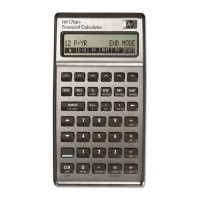hp calculators
HP 17bII+ Time-Value-Of-Money
One of the wonderful features of your HP 17bll+ is its ability to quickly calculate financial variables used in compounding and
discounting in a way that is easy to follow and therefore understandable. In learning how to do these calculations, it is important for
you to see what the five variables are that can be used in financial calculations and how they relate to one another. If you can, you
will be able to figure out what you have to do to get the right answer.
THE FIVE VARIABLES:
These five variables are in the time-value-of-money menu. To get there, start form the main menu and press ‘FIN.’ In the next menu
that pops up you should see “TVM” way to the left. Press that button and you are in the time-value-of-money menu where you will
perform your TVM calculations.
The five registers or memory banks for the financial variables are shown in your display:
N - The total number of compounding, discount, or payment periods
If you have a 30-year loan, for example, that is to be amortized on a
monthly basis, the total number of payments would be 360 (12 months
per year times 30 years) and this is the number that would go in the
‘N’ register.
I%YR - the interest rate or discount rate per year
The annual rate shows in this register and the calculator computes
what the actual rate will be per compounding or discount period. For
example, if the annual rate for a savings account is 6% and the
interest is paid (compounded) monthly, the rate per month would be
0.5% (1/12th of the annual rate of 6%). But the annual rate of 6%
would still show in the ‘I%’ register.
PV - the present value of a sum of money or series of monies
This is the amount with which you start when you open up a savings
account. Or, it may be the sum you calculate when you are
discounting a future sum to a present value. It also could be the
starting amount of a loan before payments on it begin.
PMT - payment that is paid or received on a periodic basis
A series of payments or receipts should be shown in this register. But
it must be the same amount each time that is paid or received (for
varying payments we will go to the discounted cash flow menu) and
the payments must be equally spaced apart, that is, every week, every
month, every year.
FV - the future value of a sum of money or a series of monies
This could be a future sum of money you expect to receive and want
to calculate what it is worth today, its present value. Or, it might be
how much money your savings account will have after you deposit
money in the bank and allow it to accumulate interest. It might also
be the balance of a loan at any one time as it is being amortized.
hp calculators - 2 - HP 17bII+ Time-Value-Of-Money

